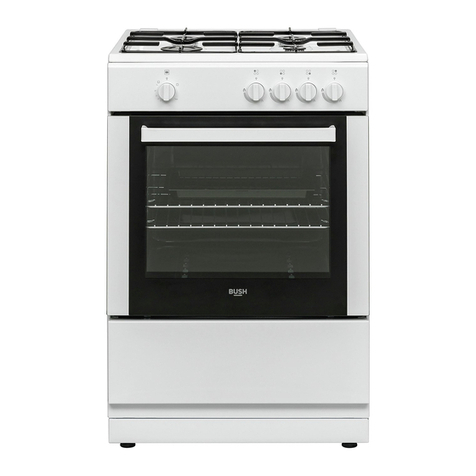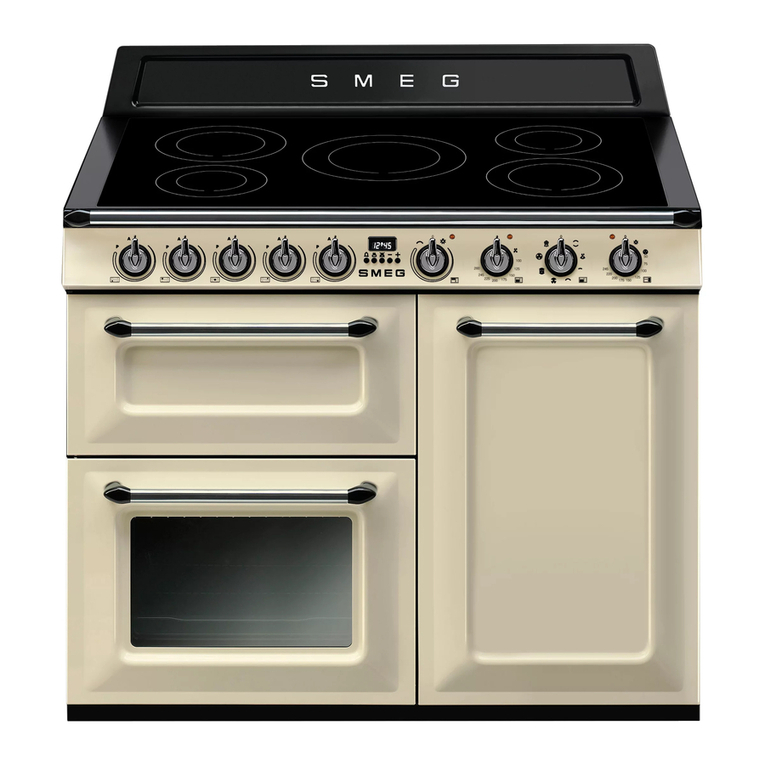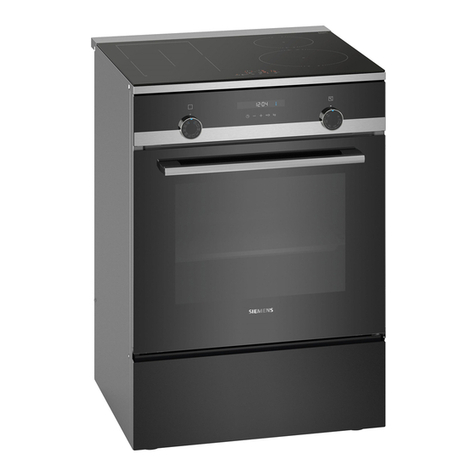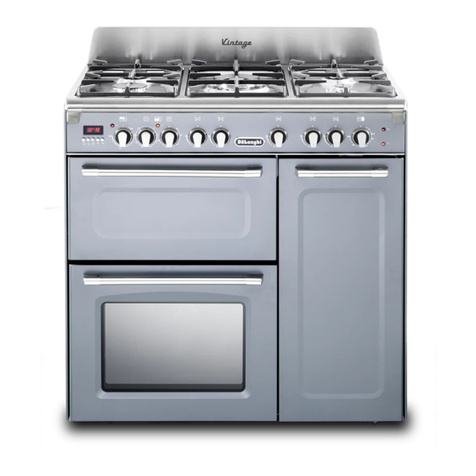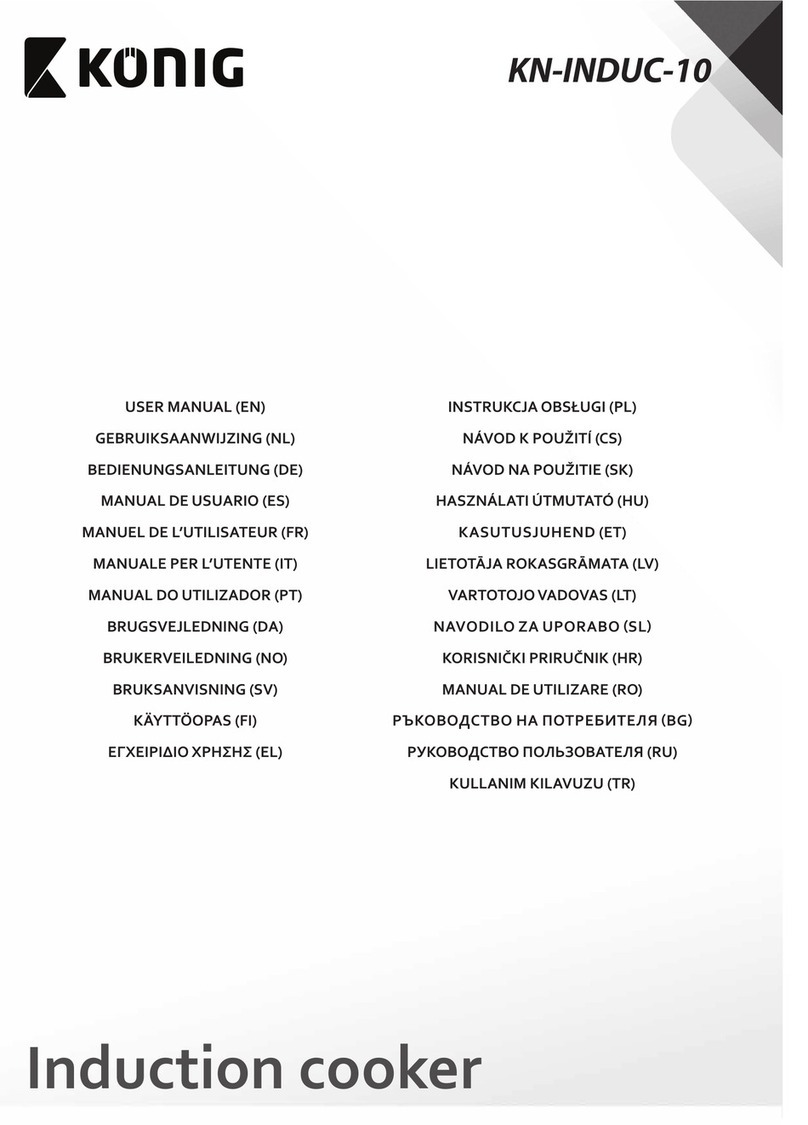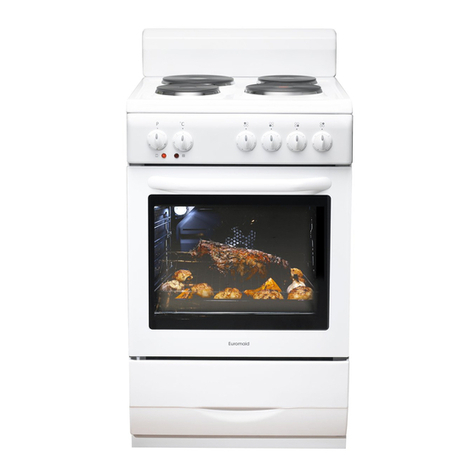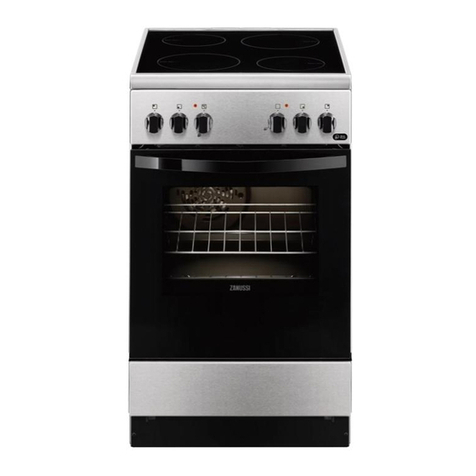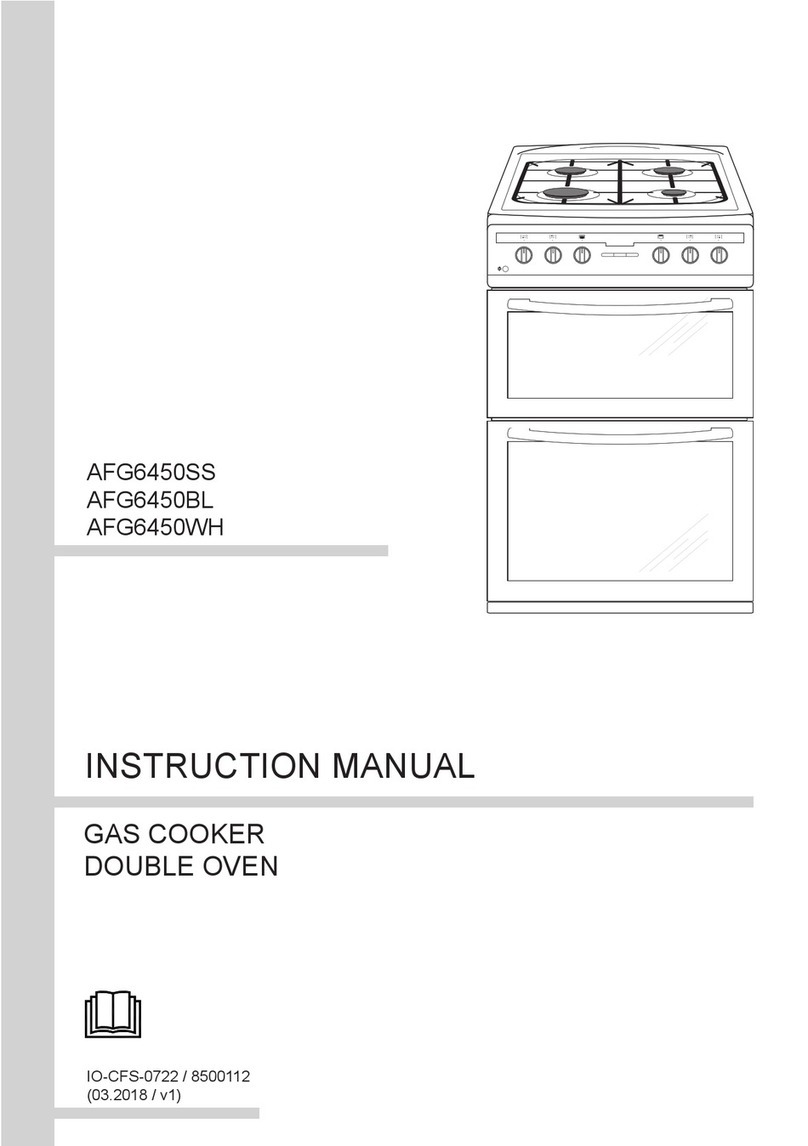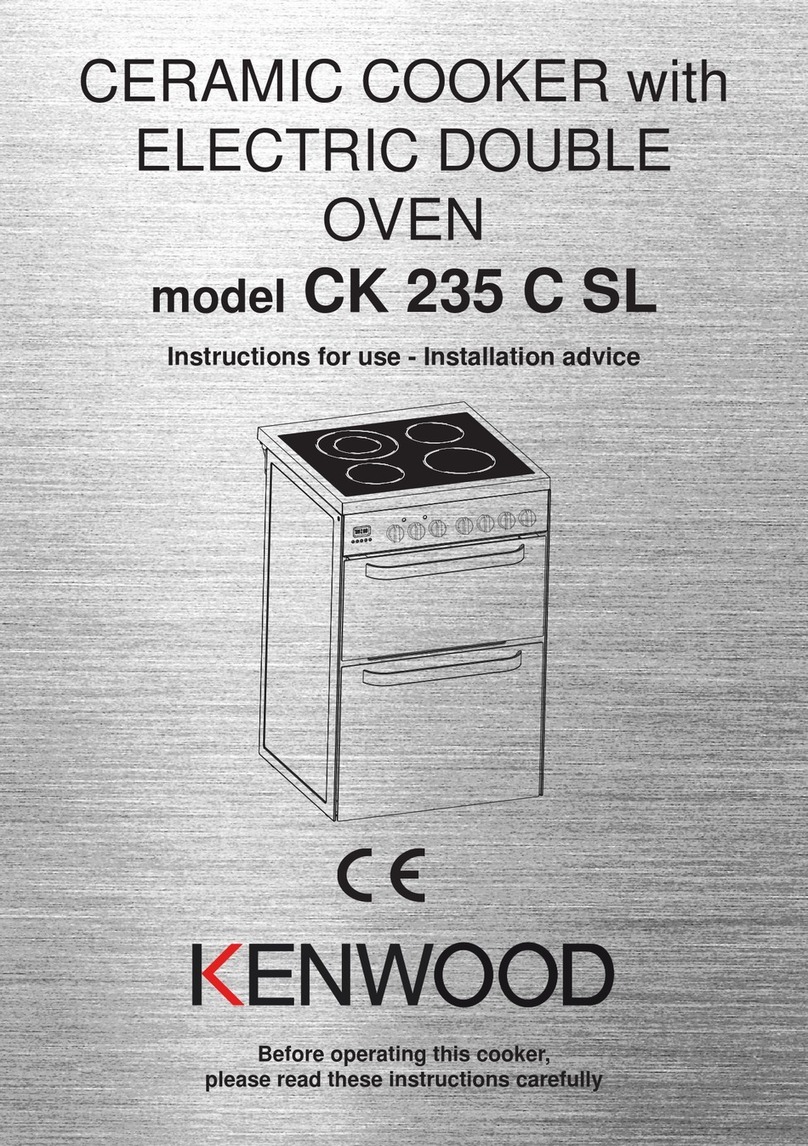Classique CLFSG60W User manual

INSTRUCTION MANUAL
Do not use the oven until you have read this instruction manual
Cod:0040302312
CLFSG60W
CLFSG60SS

DEAR CUSTOMER,TABLE OF CONTENTS
23
This appliance has been designed to be efficient and easy to use. The following
instructions will show you how to best operate your appliance to enjoy years of
hassle-free use.
It is important to keep this instruction manual and store it in a safe place so that it can
be consulted at any time.
For your peace of mind, this appliance has been thoroughly tested with regard to safety
and functionality before leaving the factory.
Caution!
Do not use this appliance until you have read this instruction manual.
This appliance is intended for household use only.
Safety instructions.....................................................................................................4
How to save energy.............................................................................................................7
Unpacking.......................................................................................................................... 7
Disposal of the appliance............................................................................................ ........7
Description of the appliance..................................................................................8
Installation......................................................................................................................9
Operation......................................................................................................................14
Prior first use............................................................................................................... ....... 14
How to use surface burners........................................................................................ ....... .. .14
Mechanical timer............................................................................................................... 16
Cleaning and maintenance................................................................................... 19
Operation in case of emergency........................................................................ 20
Baking in the oven.................................................................................................... 21
Technical information.............................................................................................. 29

SAFETY INSTRUCTIONS SAFETY INSTRUCTIONS
45
● To avoid any possible hazard, the appliance must be installed by qualified
personnel only. Installation should be carried out in accordance with the legal
regulations and technical requirements of the local gas supplier. Important
instructions in this regard may be found in the section “Installation”.
● The appliance becomes hot during operation. Take care not to touch the hot parts
inside the oven.
● Please pay attention to children in the vicinity of the appliance. In particular, hot
surface burners, the oven chamber, grates, the door pane, and pans containing hot
liquids standing on the hob may cause burns to children.
● Mind that electrical connection leads from other home appliances (e.g. of a food
mixer )do not touch hot parts of the cooker.
● Do not place flammable material into the utility drawer whilst using the oven, as it
may catch fire.
● Do not leave the cooker unattended when frying. Oils and fats may catch fire due
to overheating.
● At the point of boiling, mind to avoid spills on the burner.
● If the cooker is damaged, it may be used again only after the fault has been fixed
by a specialist.
● Do not ope n the tap on the gas connection or cylinder valve before checking that
all burner knobs are closed.
● Do not allow the burners to be soiled or liquids to spill on the burners. If soiled,
clean and dry burners immediately after they have cooled down.
● Do not put pans directly onto burners.
●Never use the burners or the oven for heating of the room. Never place empty dishes
upon the cooking zones.
● Do not place pans with a weight greater than 10kg onto the grate over one burner,
or pans with a total weight of over 40 kg on the whole grate.
● Do not open the cooker knobs before already having a lighted match or a gas lighter
in your hand.
● Do not put out a burner flame by blowing.
● Do not make your own alterations to the cooker in order to adapt it to a different
type of gas, move the cooker to another place or make changes to the power
supply. These operations may only be carried out by an authorised electrician or
fitter.
● Do not use harsh cleaning agents or sharp metal objects to clean the door as they
can scratch the surface, which could then result in the glass cracking.
● IN CASE OF ANY SUSPICION OF GAS LEAKAGE YOU MUST NOT:
Light matches, smoke cigarettes, switch electrical switches (eg. door bell or light
switch) on and off, or use other electric or mechanical devices that create electrical
or percussive sparks. In such a case, immediately close the cylinder valve or tap
cutting off gas supply, air the room, and then call a person authorized to repair the
source of the leakage.
● In the event of any incident caused by a technical fault, disconnect the power
(applying the above rule) and report the fault to the service centre to be repaired.
● Do not attach any antenna cords (e.g. radio) to the gas supply.
● In a case of gas escaping form leaky piping and catching fire, close gas supply
immediately using a cutting-off valve.
● In a case of gas escaping from a leaky cylinder and catching fire: throw a wet
blanket over the cylinder to cool it down and turn off the cylinder valve. After it has
cooled down,take the cylinder out to an open space. Do not use the damaged cylinder.
● When the cooker is not to be used for several days, close the main valve on the
gas piping.When using a gas cylinder, close it after each use.
● The cooker should not be cleaned using steam equipment.
● Do not subject the knobs and burners to sharp forces.
● Alterations and repairs carried out by an unqualified person are not allowed.
● Do not put pans weighing over 15kg on the opened door of the oven.

SAFETY INSTRUCTIONS HOW TO SAVE ENERGY UNPACKING
DISPOSAL OF THE APPLIANCE
Caution!
67
● During the operation of gas burners the room may be filled with extra heat and
humidity, so it is necessary to assure adequate ventilation. Occasional opening
of the window or door should provide enough exchange of air. During the
prolonged use of the appliance, or during a very intense use, more ventilation will
be required, and it will probably be necessary to engage the extractor hood.
● Do not use the cooker in the event of a technical fault. Any faults must be fixed by
an appropriately qualified and authorized person.
● The rules and provisions contained in this instruction manual should be strictly
observed. Do not allow anybody who is not familiar with the contents of this
instruction manual to operate the cooker.
● Never put aluminum foil on the bottom of the oven, and do not place any crockery
upon the bottom of the oven.
Using energy in a
responsible way not only
saves money but also
helps the environment. So
let's save energy!nd this is
how you can do it:
● Use proper pans for cooking.
A saucepan should never be smaller than
a burner crown.
● Ensure that the burners, the grate, and
the hob are clean.
Soiling can prevent heat transfer and, when
left alone, can often only be removed by
cleaning products which are harmful to the
environment.
In particular, pay careful attention to the
flame opening in the rings under burner
caps, and the burner nozzles.
● Do not uncover pans or open the oven
door more than necessary during cooking.
● Only use the oven when cooking larger
dishes.
Meat of up to 1 kg can be prepared more
economically in a pan on the cooker
burner.
● Make use of residual heat from the oven.
If the cooking time is greater than
40 minutes, it is recommended to switch off
the oven 10 minutes before the end time.
● Make sure the oven door is properly
closed.
Heat can leak through spillages on the
door seals. Clean up anyspillages
immediately.
● Do not install the cooker in the direct
vicinity of refrigerators/freezers.
Otherwise household energy consumption
increases unnecessarily.
Duringtransportation,
protective packaging
was used to protect the
appliance against
any damage.
After unpacking, please dispose of all
elements of packaging in a way that will
not cause damage to the environment.
All materials used for packaging the
appliance are environmentally friendly;
they are 100% recyclable and are marked
with the appropriate symbol.
During unpacking, the packaging
materials (polythene bags, polystyrene
pieces, etc.) should be kept out of reach
of children.
Old appliances should not
simply be disposed of with
normal household waste,
but should be delivered to
a collection and recycling
centre for electric and
electronic equipment.
A symbol shown on the product, the
instruction manual or the packaging shows
that it is suitable for recycling.
Materials used inside the appliance are
recyclable and are labeled with information
concerning this. By recycling materials or
other parts from used devices you are
making a significant contribution to the
protection of our environment.
Informationon appropriatedisposal centers
for used devices can be provided by your
local authority.

DESCRIPTION OF THE APPLIANCE INSTALLATION
Installing the cooker
750mm
2cm2cm 2cm2cm2cm2cm
89
89
The following instructions are addressed to
the qualified specialist installing the cooker.
These instructions aim to ensure that
installation is performed as professionally
as possible.
● The kitchen where the appliance is to
be installed must be dry and well
ventilated.
● The room should be equipped with a
ventilation system that pipes away
exhaust fumes created during
combustion. This system should
consist of a ventilation grid or hood.
Hoods should be installed according
to the manufacturer's instructions.
The cooker should be placed so as
to ensure free access to all control
elements.
● The room should also enable the
necessary air supply for propergas
combustion. Air supply should be not
less than 2m³/h per 1 kW of burner heat.
The air can be delivered from outside by
a duct with a section of at least 100 mm²,
or indirectly from adjoining rooms fitted
with ventilation ducts leading outside.
● If the appliance is used for extended
periods, it may be necessary to open
a window in order to boost ventilation.
● In terms of protection against the
overheating of surrounding surfaces,
the gas cooker is an X–class appliance
and can be built into furniture only
up to the level of the cooking hob; that
is around 850 mm above the floor.
Raising furniture construction over
this level is inadvisable. Coating or
veneer used on fitted furniture must be
applied with a heat resistant adhesive
(100℃). This prevents surface
deformation or detachment of the coating.
If you are unsure of your furniture's heat
resistance,you should leave
approximately 2 cm of free space
around the cooker. The wall behind the
cooker should be resistant to high
temperatures. During operation, its back
side can warm up to around 50℃
above the ambient temperature.
● The cooker should stand on a hard,
even floor (do not put it on a base).
● Before you start using the cooker, it
should be leveled, which is particularly
important for fat distribution in a frying
pan. To this purpose, adjustable feet
can be found upon removing the utility
drawer. The adjustment range is +/-5mm.
Medium burner
Medium burner
Auxiliary burner
Large burner
Grate
Temperature
regulator knob
Gas burner
control knobs
Oven door
handle
Drawer
Oven operation
signal light red
Mechanical
timer knob
Oven function
selection knob

INSTALLATION
Gas connection
Caution!
Fitting guidelines
A fitter should:
Caution!
INSTALLATION
Hose connection
Caution!
Flexible hose connection
AA
BB
CC
DD
Beginning of operation
11
10
9
Liquefied gas connection
9 Pipe coupling liquefied
10 Gasket
11 Connection R 1/2
10 11
Caution!
Fix the cooker to the back wall
with 2 chains
● Install the cooktop
Remove the crown caps and burner
crowns from the oven, and arrange
them on the cooktop as per the earlier
diagram entitled 'Description of the
appliance! These components will fit
together neatly when correctly installed.
The crown cap and burner cap must be tightly
installed to ensure that the gas flame burns
as intended. If the flame fails to ignite, it may
be because these components have been
incorrectly installed.
The cooker should only be connected to a
gas supply of the particular type that the
appliance is manufactured to function with.
Information about the type of gas that the
cooker has been adapted to by the factory
is shown on the data plate. The cooker
should be connected exclusively by an
appropriately authorized fitter and only he
or she has the right to adapt the cooker to
a different type of gas.
Have a gas fitter's authorisation
Be acquainted with the information
included on the data plate of the cooker
about the type of gas to whichthe cooker
is adapted
Check:
-airing efficiency, that is efficiency of
air exchange in the rooms,
-tightness of gas fitting connections,
-effectiveness of allfunctional elements
of the cooker,
-if the electricity supply is adapted to
function with a safety ground lead
(zero)
provide the user with a connection
certificate and give him or her
instructions in cooker use.
The cooker may only be connected to a
liquid gas cylinder or the existing gas
supply by an authorized fitter, observing all
safety rules.
The appliance is equipped with a gas
connection on the right side with
exterior thread ISO 228-R1/2.
Certain appliances are supplied with
the attached liquid gas coupling and
the sealing gasket.
The connection R1/2 must be gripped
tight during the connection procedure to
prevent it from revolving.
Use metal or non-metal gaskets for
connection packing. Gaskets are
intended for single use only.
Deformation of the non-metal
gasket connection thickness during
tightening may not exceed 25%.
Connect the appliance to the gas
coupling by means of certified flexible
hose. The hose may not touch the
bottom panel of the appliance or the
rear panel and ceiling of the oven.
Connect the appliance in accordance
with the regulations of the local gas
supplier.
On completion of the cooker installation,
the tightness of all connections should be
checked, e.g. applying water with soap.
Do not use fire to check tightness.
In case the appliance is connected by
means of a flexible hose, the position A
of the hose is not permissible.
In case the connection hose is made of
metal, position A is permissible.
Start using the appliance in accordance with
the instructions for use.
Ignite all burners and check the stability of
the flame with high and low setting. Adjust
air intake if necessary. After that, take time
and explain the operation and control of
the appliance to the user, referring to this
instruction manual as necessary.

INSTALLATION
Adapting the cooker to
another type of gas
be
Caution!
In order to adapt the cooker to burn a
different type of gas, you should:
● Exchange nozzles (see tables below),
● Adjust the flame intensity.
Burner
Burner flame
Re-arming from liquid
gas
to natural gas
Re-arming from natural
gas
to liquid gas
Full
1. Exchange a burner nozzle for the
appropriate type according to the
nozzle table
1. Exchange a burner nozzle for the
appropriate type according to the
nozzle table.
Economical 2. Unscrew an adjusting bolt slightly
and adjust the flame size.
2. Screw in an adjusting bolt slightly
to the end and check the flame size.
In order to perform the above adjustment, remove the gas burner control knobs.
INSTALLATION
Caution!
Fig. B
A knob with a
surface burner
safety valve
12 13
Nozzle type/diameter
Type of gas
auxiliary medium large
G30 /30 mbar 0.50 0.65 0.90
This operation may only be carried out by
an appropriately authorised fitter.
The cooker is to supplied with natural gas
(G20/20mbar). To adapt the cooker to
another type of gas, the burner nozzles
must be exchanged and the flame adjusted. When leaving the factory, burners are
adapted to use the gas specified on their
data plates and guarantee cards.
A correct flame has distinct int ernal cones of blue and green colour. A short, humming
flame or long, yellow and smoking one, without clearly outlined cones, shows improper
quality of gas in the household piping or a damaged or soiled burner. In order to check a
flame, heat a burner for around 10 minutes with a full flame, and next turn the valve knob
to the economical flame position. The flame should not go out or jump onto the nozzles.
Surface burners do not require adjustment of primary air.
Replacement of a burner
nozzle: Unscrew the
nozzle with special socket
spanner No 7 and replace
with a new one according
to the type of gas
(see tables)
In cookers with a safety device, a knob with
a surface burner safety valve is used, (Fig. B).
Knobs should be adjusted with the burner
switched on and set to the economical
flame position, using an adjustment
screwdriver of the 2.5mm size.
● Adapting the appliance to a different
type of gas than that indicated by the
manufacturer of the cooker on the data
plate, or purchasing a cooker for a different
type of gas than supplied to thehouse, is
exclusively the responsibility of the user
and the fitter.
● After adjustment is completed, affix a
label to the cooker indicating the type
of gas to which the cooker is now adapted.

OPERATION
Before first use
How to use surface burners
Choice of cookware
WRONG RIGHT
Gas burner control knobs
OPERATIONOPERATION
Ignition without an ignitor
Light a match.
Press in the knob to the end and turn
it left to the “large flame” position ,
Ignite gas with a match.,
Set required flame size (e.g.
“economical” ),
Switch off the burner after finishing
cooking, turning the knob right (to the
off position ).
Knob ignition
Press in the knob to the end and turn
it left to the “large flame” position ,
Hold until gas is lit,
After the flame is lighted release the
pressure on the knob and set a
required flame size.
Caution!
●
Selection of the approprite flame
WRONG RIGHT
Large flame
Small flame (“economical flame”)
Burner switched off (gas supply is cut
off)
Depending on requirements, flame size
can be set in a continuous manner.
14 15
Gas burner control knobs
Postition
burner"switched off"
Position
"large flame"
Position
"economical flame"
Caution!
● are
● If the flame goes out repeat the
procedure.
● If the burner flame extinguishes,
● Before igniting the burners cover them
with appropriate cookware.
Remove packaging elements,
Gently (slowly) remove labels from the
oven door, trying not to break the glue
tape. If any visible trace is left on the
glass, warm up the oven chamber (see
below), spray the warmed-up glass with
a glass cleaner, and wipe off with a soft
cloth.
Empty the utility drawer, and clean off
factory preservatives from the oven
chamber with warm soapy water
Take out and wash the oven fittings with
warm water and a little washing-up
liquid,
Switch on the ventilation in the room or
open a window,
Heat the oven (to a temperature of
250℃ , for approximately 30 min.),
remove any stains and wash carefully.
When handling the cooker, follow the
safety instructions carefully.
When heating the oven for the first time,
it is normal for it to give off smoke and
a peculiar smell. This will disappear
about 30 minutes later.
The oven chamber should only be
washed with water and a small amount
of washing-up liquid.
Mind that the diameter of a pan base is
always larger than the burner flame crown,
and that the pan itself is covered. The
recommended pan diameter is around 2.5
to 3 times larger than the burner diameter,
that is, for:
● An auxiliary burner – a pan with a
diameter of 90 to 150 mm,
● A medium burner – a pan with a
diameter of 160 to 220 mm,
● A large burner – a pan with a diameter
of 200 to 240 mm, and the pan height
should not be greater than its diameter.
In cooker models equipped with a surface
burner safety valve, hold the knob pressed
down to the end when igniting for 10
seconds at the “large flame” position to a
ctivate the safety device.
If the ignition device is out of order, either
due to power failure or humid ignition
device, use a match or a lighter to ignite
the gas.
● Keep the button pressed for approximately
10 second after ignition to stabilize the
flame.
● If you failed to ignite the burner after
15 seconds. Shut the burner off and
wait for at least one minute before the
next attempt.
A correctly adjusted burner has a light blue
flame with a clearly visible internal cone.
Flame size depends on the position of the
burner knob which has been set:
● Button positions between and
are not recommended. In these
positions, the flame is not stabilized
and may be extinguished.
shut the burner off and wait for at least
one minute before next attempt.

OPERATION OPERATION
17
16
Please note!
When selecting any oven function,
temperature has been set by the
Temperature control knob
Fan forced
Possible settings of the oven function
knob
Please note!
When selecting any heating function, the
oven will only be switched on after the
temperature has been has been set by
the temperature regulator knob.
The four function knob(with rear heater)
Air movement inside the oven cavity is
Defrost
Heat coming solely from the bottom of the
Lower element
ovenmakes it possible to cook foods with a
Fan assisted
Conventional Bake
Heat originates from above and below the
food, yielding a traditional baking effect
Fan grill
The mechanical timer knob
Oven functions and operation
Caution!
When selecting any oven function, the
oven will only be switched on after the
temperature has been set by the
temperature selection knob.
If you don't want the oven work
controlled by the mechanical timer ,
you can turn the mechanical timer to
the position
100
150
200
250
50
100
150
200
250
50
the oven will only be switched on after the
temperature control knob.
When using the oven, you must set the
mechanical timer to manual mode, or
set a time.
Radiant heat from the grill element is
combined with the recessed upper bake
element, yielding an intense browning effect,
enabling large quantities of food, particularly
meat, to be grilled evenly.
diminished browning effect. This is
recommended for pies, tarts, and pizzas.
Heat from the conventional bake elements
is distributed with assistance from the fan,
to encourage uniform cooking with complex
recipes. This mode is effective for cooking
biscuits and cakes, even when cooked on
several levels.
generated by the fan. This mode is effective
at defrosting food.
Grill and upper element
A heating element around the fan enables
the most uniform heating possible. This
mode minimises preheating time, and is
also the best for cooking several different
types of food at once.
Air movement inside the oven softens the
intense heat of the grill, optimal for the
cooking of thick cuts of meat, for example.
that is best for cooking one dish at a time.
This mode is suitable for roasts, bread,
cakes, and fatty meats such as goose or duck.

OPERATION
18 19
Oven guide levels
11
22
33
44
55
Use of the grill
In order to switch on the grill you need to:
Set the oven knob to the position
marked with .
Heat the oven for approximately 5
minutes (with the oven door shut).
Insert a tray with a dish onto the
appropriate cooking level, and if you
are grilling on the grate insert a tray
for dripping on the level immediately
below (under the grate)
The oven door shut.
Caution!
The grill should be used with the oven door
shut.
When the grill is in use, accessible parts
can become hot.
It is recommended to keep children away
from the oven.
CLEANING AND MAINTENANCE
Front side of the casting
Cooktop
Caution!
Baking pans and accessories (oven grid,
baking tray, etc) may be inserted into the
oven in 5 guiding levels.
Appropriate levels are indicated in the
tables that follow.
Always count levels from the bottom
upwards!
The grilling process operates through
infrared rays emitted onto the dish by the
incandescent grill heater.
By ensuring proper cleaning and
maintenance of your cooker you can have
a significant influence on the continuing
fault-free operation of your appliance.
Before you start cleaning,the cooker must
be switched off and you should
ensure that all knobs are set to the"●"
position. Do not start cleaning until
the cooker has completely cooled.
To clean the exterior of the appliance,
use only warm soapy water.
Never use any aggressive cleaning
agents or dish cleaning accessories
which might cause scratches.
The cooktop and burner components
should be cleaned with warm water and
mild detergent for manual washing
of dishes.
The thermal element and ignition
device should be cleaned with soft
brush. To ensure perfect operation,
these elements must always be
thoroughly clean.
Always keep the gas nozzles on the
burner crown free of dirt.
Upon completion of cleaning, wipe all
components dry and replace them
carefully to their respective slots.
Incorrect placement of burner
components may prevent ignition.
Crown caps are coated with black
enamel. Discoloration of caps,due to
high temperatures, is inevitable, but is
has no adversarial effect on normal o
peration of burners.

22 23
Oven
Caution!Caution!
Do not use cleaning products containing
abrasive materials for the cleaning and
maintenance of the glass front panel.
CLEANING AND MAINTENANCE
Replacement of the oven light
bulb
Oven light bulb
Screw the bulb in, making sure it is
properly inserted into the ceramic
socket.
Screw in the lamp cover.
CLEANING AND MAINTENANCE
Door removal
Door removal
Removal of the internal glass
panel
Unscrew and unfasten the plastic latch that
is in the corner at the top of the door. Next
take out the glass from the second
blocking mechanism and remove. After
cleaning, insert and block the glass panel,
and screw in the blocking mechanism.
Removal of the internal glass panel
Regular inspections
Besides keeping the cooker clean, you
should:
Fix any operational faults.
Carry out periodical maintenance of
the cooking units of the cooker.
Caution!
The oven should be cleaned after
each use.
The oven chamber should only be
washed with warm water and a small
amount of washing-up liquid.
After cleaning the oven chamber, wipe
it dry.
Cool the oven completely before
cleaning.
Never clean theappliance with
pressurised hot steam cleaner!
Steam cleaning:
-pour 250ml of water (1 glass) into a
bowl placed in the oven on the first level
from the bottom.
-Close the oven door,
-Set the temperature knob to 50℃,and
the function knob to the bottom heater
position,
-heat the oven chamber for
approximately 30 minutes,
-Open the oven door, wipe the
chamber inside with a cloth or sponge
and wash using warm water with
washing-up liquid.
Caution! Possible moisture or water
residues under the cooker can result
from steam cleaning.
In order to avoid the possibility of an
electric shock, ensure that the appliance
is switched off before
replacing the bulb.
Set all control knobs to the position
“●” and disconnect the mains plug.
Unscrew and wash the lamp cover
and then wipe it dry.
Unscrew the light bulb from the
socket, replace the bulb with a new
one – a high temperature bulb (300℃)
with the following parameters:
-voltage 230 V
-power 25 W
-thread G 9 or E14.
In order to obtain easier access to the oven
chamber for cleaning, it is possible to
remove the door. To do this, tilt the safety
catch part of the hinge upwards, close the
door lightly, lift and pull it out towards you.
In order to fit the door back on to the cooker,
do the inverse. When fitting, ensure that
the notch of the hinge is correctly placed
on the protrusion of the hinge holder. After the
door is fitted to the oven, the safety catch
should be carefully lowered down again,
if the safety catch is not set it may cause
damage to the hinge when closing the door.
Carry out periodic inspections of the
control elements and cooking units of
the cooker. After the guarantee has
expired you should have a technical
inspection of the cooker carried out at
a service centre at least once every
two years.
All repairs and regulatory activities should
be carried out by the appropriate service
centre or by an appropriately authorized fitter.

20 21
OPERATION IN CASE OF EMERGENCY
In the event of an emergency, you should:
Switch off all working units of the cooker
Disconnect the mains plug
Call the service centre
Some minor faults can be fixed by referring to the instructions given in the table below.
Before calling the customer support centre or the service centre check the following
points that are presented in the table.
PROBLEM REASON ACTION
Burner flame is not steady. Wrong setting of gas.
Expert should set the gas escape
properly!
Burner flame suddenly changes Incorrect assembly of burner
components.
Assemble the burner components
correctly!
The flame goes off after ignition. Early release of control button.
Control button is not pushed in
firmly.
Keep the button pressed longer.
Before releasing the button, give it one
final solid push.
The color of the cooking zone
gas grid has changed.
Normal situation, caused by the
high temperature.
Clean the grid with metal cleaning
agents.
Electric operations are generally
disturbed.
Fuse is burned. Check the fuse in the fuse box, and
replace if required.
Electric ignition of burners does
not function.
Food residues or detergent block
the contact between the ignition
device and the burner.
Open and clean carefully the opening
between the ignition device and the
burner.
Burner crown caps look ugly. Usual staining. Clean the crown cap with metal cleaning
agents.
Dew forms at oven door glass
during heating up.
Normal situation, caused by the
temperature difference.
No remedy; it does not impede normal
operation.
Roasting temperature too high Reduce roasting temperature. …if you detect smoke during
roasting? Thermostat failure. Experts should replace the thermostat.
Oven is excessively stained
during roasting.
Roasting temperature is too
high.
Grid rack and grease tray are
incorrectly placed.
Reduce the roasting temperature,
Place the grid above the grease tray and
insert them both in the guide.
Liquid or pastry dough is lifted to
on side.
The appliance is not leveled. Level the appliance into horizontal
position by setting the adjustable legs.
Baking results are disappointing. Wrong oven setting. Select correct oven setting according to
the instructions from the baking tables.
Flat cake is too light from below. Baking pan was placed in top of
roasting pan.
Place the baking tray upon the grid rack.
Pastry is too dry. Temperature is too low.
Baking time too long.
Set higher oven temperature duce
baking time.
Pastry is slippery, smeary and
mellow. Meat is rare in the
middle.
Baking temperature is too high.
Roasting time is too short.
Excessive quantity of liquid in
dough.
Reduce the temperature – baking time
may not be reduce d by setting higher
temperature (roasted from the outside,
raw from the inside) select longer baking
time, let the dough rise longer.
Add less liquid to the dough.
The appliance does not work. Break in power supply. Check the household fuse box; if there
is a blown fuse replace it with a new one
The programmer display is
flashing”0.00”.
The appliance was disconnected
from the mains or there was a
temporary power cut.
Set the current time (see ‘Use of the
programmer’ )
The oven lighting does not work. The bulb is loose or damaged. Tighten up or replace the blown bulb
(see ’Cleaning and Maintenance’)
BAKING IN THE OVEN
Baking pastry
Warning!
Baking with upper and lower
heaters
Use only a single guide level.
Preheating shortens the baking time. Do
not put the cake in the oven until proper
temperature is obtained.
Baking tips
Is pastry baked?
Pastry has fallen
Pastry is too light below
Cheese cake is undercooked
Next time reduce the baking temperature
and extend the baking time.
Warnings regarding the baking
tables
Most appropriate position for baking is the
application of both upper and lower heater,
or the hot air.
The baking parameters given in Tables
are approximate and can be corrected
based on your own experience and
cooking preferences;
In case you may not fin d any particular
type of cake in the tables, use the
information available for the next most
similar type of cake.
This baking position is especially suitable
for baking dry pastry, bread and teacakes.
Use dark baking pans. Light pans reflect
heat and pastry is not adequately
browned.
Always place baking pans on the grid
rack. Remove th e grid only of baking in
the flat biscuit tray, supplied with the
appliance.
Pierce the cake with a wooden peg at the
thickest part, if the dough does not stick to
it, the cake is baked. You may switch off the
oven and use the remaining heat.
Check the recipe. Use less fluid next time.
Follow the mixing times, especially when
using powered kitchen mixers.
Use dark baking pan next time, or place
the pan one level lower, or switch on the
lowerheaterawhilebeforethe completion.
The tables indicate the temperature
range. Always select lower temperature
first. You may always increase the
temperature in case pastry needs more
baking.
Baking times are indicative only. They
may vary in dependence of individual
characteristics.
The asterix indicates that the
oven requires preheating.

24 25
Pastry Baking Table
BAKING IN THE OVEN
Type of pastry Guide level
(from down
upwards)
Temp(℃)
Guide level
(from down
upwards)
Temp(℃)
Baking time
(in min.)
Sweet pastry
Raisin cake 2 160-170 2 150-160 55-70
Ring cake 2 160-170 2 150-160 60-70
Tree cake (tart
form)
2 160-170 2 150-160 45-60
Cheese cake
(tart form)
2 180-190 3 160-170 60-80
Fruit cake 2 190-200 3 170-180 50-70
Fruit cake with
icing
2 180-190 3 160-170 60-70
Sponge cake 2 180-190 2 160-170 30-40
Flake cake 3 190-200 3 170-180 25-35
Fruit cake mix
dough
3 180-190 3 160-170 50-70
Cherry cake 3 190-210 3 170-200 30-50
Jelly roll 3 190-200 3 170-180 15-25
Fruit fan 3 160-170 3 150-160 25-35
Plait bun 2 190-210 3 180-210 35-50
Christmas cake 2 180-190 3 170-200 45-70
Apple pie 2 190-210 3 170-200 40-60
Puff paste 2 180-190 3 160-170 40-60
Salted pastry
Bacon roll 2 190-200 3 170-180 45-60
Pizza 2 220-240 3 210-230 30-45
Bread 2 200-220 3 180-210 50-60
Rolls 2 210-230 3 200-220 30-40
Cookies
Caraway roll 3 180-190 3 160-170 15-25
Biscuits 3 180-190 3 160-170 20-30
Danish pastry 3 190-210 3 170-200 20-35
Flaky pastry 3 200-210 3 180-200 20-30
Cream puff 3 190-210 3 170-200 25-45
Deep frozen
pastry
Apple pie,
cheese pie
2 190-210 3 170-200 50-70
Cheese cake 2 190-200 3 170-180 65-85
Pizza 2 210-230 3 200-220 20-30
Chips for oven 2 210-230 3 200-220 20-35
Potato fries for 2 210-230 3 200-220 20-35
BAKING IN THE OVEN
Roasting
Tips regarding roasting pans
Attention when roasting!
Best results are obtained with the
engagement of both upper and lower.
Best heating mode for each type of
roasting pan is indicated by bold print in
the Roasting Tables.
Use light enamel pans, temperature
resistant glass pans, clay dishes or
wrought iron dishes.
Stainless steel dishes are not
recommended because they
excessively reflect heat.
Cover your roast or wrap it in foil. It will
preserve its juice and the oven will
remain cleaner.
If you leave the pan uncovered the roast
will be cooked sooner. Roast large
chunks of meat directly on the grid, with
intercepting pan underneath.
Roasting tables indicatesuggested temperatures,
guide level and roasting times. Roasting
time largely depends upon the type of meat,
its size and quality. So you may expect some
variations
Roasting of large chunks of meat may
produce excessive steaming and dew
formation at the oven door. This is quite
normal, and does not affect the operation
of the oven.
However, after the completion of
roasting wipe the oven door and the
glass thoroughly.
Roasting of red meat, poultry and fish is
rational if the roast exceeds one kilogram
in size.
Add as much liquid as necessary to
prevent burning of juice, dripping from
neat. Roast must be surveyed at all
times. And liquid added if necessary.
At approximately the middle of the
indicated time turn the roast round,
especially if you use the deep roast dish.
When roasting on the grill grid, place the
grid in the deep roasting pan and insert
both into the sliding guide. The bottom
pan will intercept dripping fat.
Never leave roast to cool in the oven, as
it might produce dew and corrosion of
the oven.

26 27
BAKING IN THE OVEN
Roasting table
Type of meat Weight
(in grams)
Guide level
(from
bottom up)
Temp
(℃)
Roasting
time
(in min.)
temp
(℃)
Roasting
time
(in min.)
Beef
Beef loin 1000 2 210-230 2 200-220 100-120
Beef loin 1500 2 210-230 2 200-220 120-150
Roast beef,
rare
1000 2 230-240 2 220-230 30-40
Roast beef,
well done
1000 2 230-240 2 220-230 40-50
Pork
Pork roast with
skin
1500 2 190-200 2 170-180 140-160
Flank 1500 2 200-210 2 180-190 120-150
Flank 2000 2 190-210 2 170-200 150-180
Pork loin 1500 2 210-230 2 200-220 120-140
Meat roll 1500 2 210-230 2 200-220 120-140
Pork cutlet 1500 2 190-210 2 170-200 100-120
Minced meat
roast
1500 2 220-230 2 210-220 60-70
Veal
Veal roll 1500 2 190-210 2 170-200 90-120
Veal knuckle 1700 2 190-210 2 170-200 120-130
Lamp
Lamp prime
ribs
1500 2 200-210 2 180-200 100-120
Mutton blade
bone
1500 2 200-210 2 180-200 120-130
Venison
Hare ribs 1500 2 200-220 2 180-210 100-120
Hare blade
bone
1500 2 200-220 2 180-210 100-120
Boar ham 1500 2 200-220 2 180-210 100-120
Poultry
Chicken entire 1200 2 210-220 2 200-210 60-70
Hen 1500 2 210-220 2 200-210 70-90
Duck 1700 2 190-210 2 170-200 120-150
Goose 4000 2 170-180 2 150-160 180-200
Turkey 5000 2 160-170 2 140-150 180-240
Fish
Fish, entire 1000 2 210-220 2 200-210 50-60
Fish soufflé 1500 2 190-210 2 170-200 50-70
BAKING IN THE OVEN
Grilling Tips for grilling
Take extra precautions when grilling.
Intensive heat from infrared heater
makes the oven and the accessories
extremely hot. Use protective gloves and
barbecue accessories!
Perforated roast may produce spurting
of hot grease(sausages).Use long grill
tongs to prevent skin burns and protect
your eyes.
Supervise the grill at all time. Excessive
heat may quickly burn your roast and
provoke fire!
Do not let the children in the vicinity of
the grill.
Grill heater is especially suitable for the
preparation of low -fat sausages, meat
and fish fillets and steaks, and for browning
and crisping the roast skin.
Grilling should be carried out with the
oven door closed.
Grilling tables indicate the
recommended temperature, guide levels
and grilling times, which may vary
according to the weight and quality of
meat
Grill heater should be pre -heated for 3
minutes.
Oil the grill grid before placing the food,
otherwise food might stick to the grid.
Place the meat upon the grid, then place
he grid upon the grease interception
pan. Insert both trays into the oven
guides.
Turn the meat round after half of the
roasting time has expired. Thinner slices
will require only one turn, for larger
chunks you might need to repeat the
procedure. Always use barbecue tongs
to avoid losing excessive juice from
meat.
Dark beef meat is grilled quicker than
lighter pork or veal.
Clean the grill, the oven and the
accessories each time after use.

28 29
BAKING IN THE OVEN
Grill table
Type of meat for grill Weight
(in grams)
Guide
level (from
bottom up)
Temp(℃)
Grill time
(in min.)
Meat and sausages
2 beefsteaks, rare 400 5 240 14-16
2 beefsteaks, medium 400 5 240 16-20
2 beefsteaks, well done 400 5 240 20-23
2 pork scrag fillets 350 5 240 19-23
2 pork chops 400 5 240 20-23
2 veal staeks 700 5 240 19-22
4 lamb cutlets 700 5 240 15-18
4 grill sausages 400 5 240 9-14
2 slices of meat cheese 400 5 240 9-13
1 chicken, halved 1400 3 240-250 28-33(1.side)
23-28(2.side.)
Fish
Salmon fillets 400 4 240 19-22
Fish in aluminium foil 500 4 230 10-13
Toast
4 slices of white bread 200 5 240 1,5-3
2 slices of whole meal 200 5 240 2-3
Toast sandwich 600 5 240 4-7
Meat/poultry
Chicken 1000 3 180-200 60-70
Pork roast 1500 3 160-180 90-120
Pork scrag 1500 3 160-180 100-180
Pork knuckle 1000 3 160-180 120-160
Roast beef/ beef fillet 1500 3 190-200 40-80
TECHNICAL INFORMATION
Complies with EU regulations EN 50304, EN 60335 -1, EN 60335-2-6 standards
TYPE
Dimensions
(height/width/depth) cm 90/60/60
Cooking zone burners
Rear left (kW) 1.75
Front left(kW) 1.75
Front right(kW) 3
Rear right(kW) 1
Oven
Temperature regulator /
function mode switch 1/1
Guide levels (telescopic
guides in 3levels-only
certain models)
5
Top/bottom heater(kW) 0,85/1,
15
Grill heater(kW) 1.1
Oven illumination(W) 25
Function modes
Top/bottom heater(kW) 2,0
bottom heater(kW) 1.15
Top/bottom heater/fan
(kW) 2,0
Bottom heater/fan 1,15
Top/grill (kW) 1.95
Max. temperature 250℃
Electric connection 400 V 3N-,50Hz
Nominal voltage of
heaters 230V
Total connected
power(kW) 2.0
Total burners(kW) 7.5
Weight(kg) 45
Energy rating On the energy label
CLFSG60W CLFSG60SS
90/60/60
1.75
1.75
3
1
7.5
45
On the energy label
0,85/1,
15
1.1
25
2,0
1.15
2,0
1,15
1.95
250℃

This manual suits for next models
1
Table of contents
Popular Cooker manuals by other brands

SEF
SEF CBW-35A user manual

SAPIRHOME
SAPIRHOME SP-1445-K instruction manual
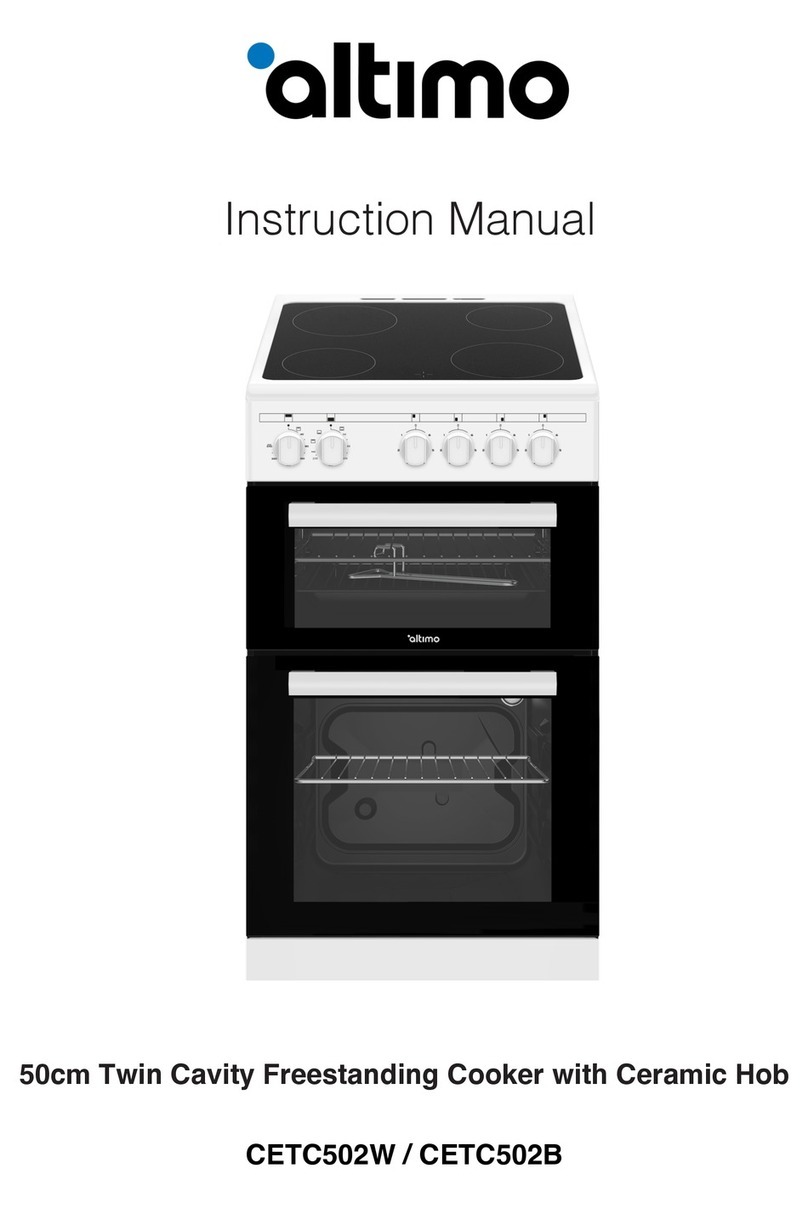
altimo
altimo CETC502W instruction manual
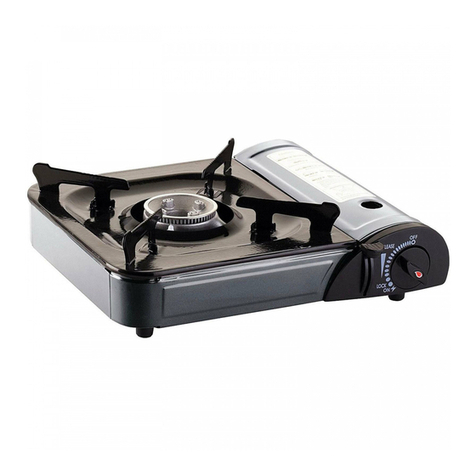
Kemper
Kemper 104987 SMART INSTRUCTIONS FOR THE ASSEMBY, THE USE AND THE MAINTENANCE
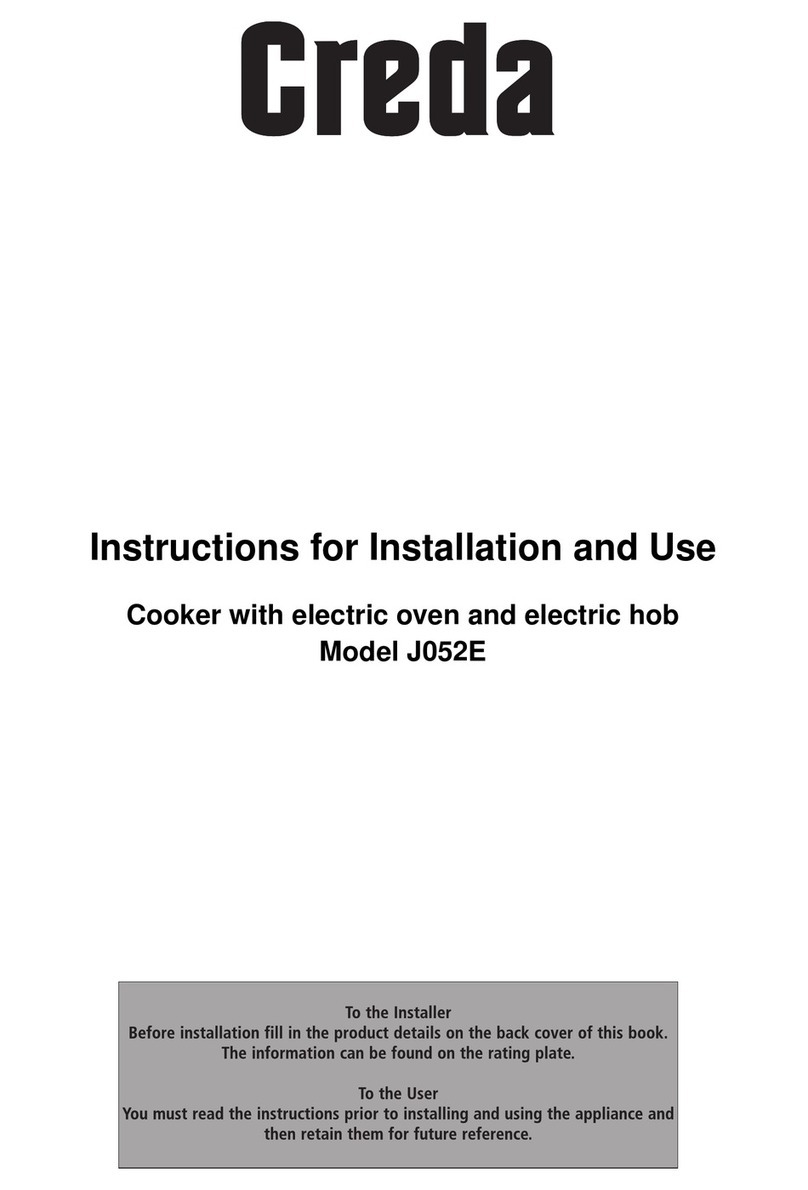
Creda
Creda J052E Instructions for installation and use

Garland
Garland Starfire Series Installation and operation manual

